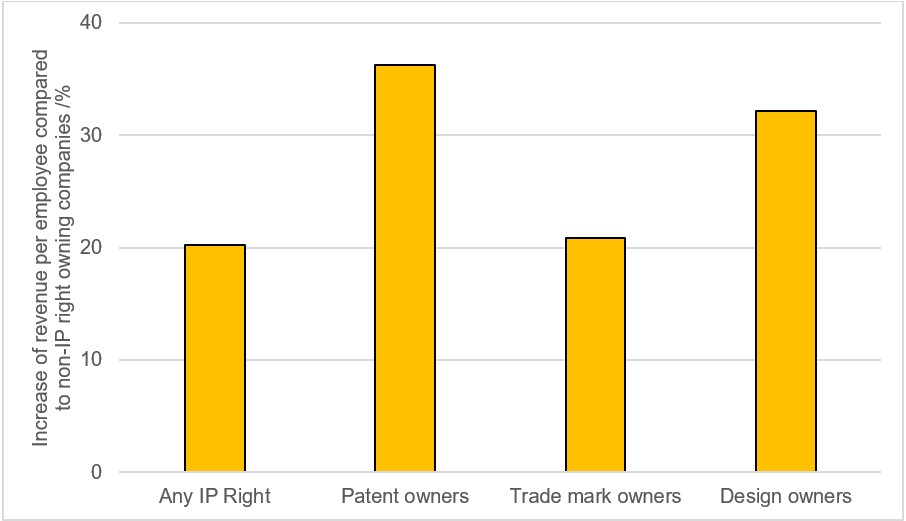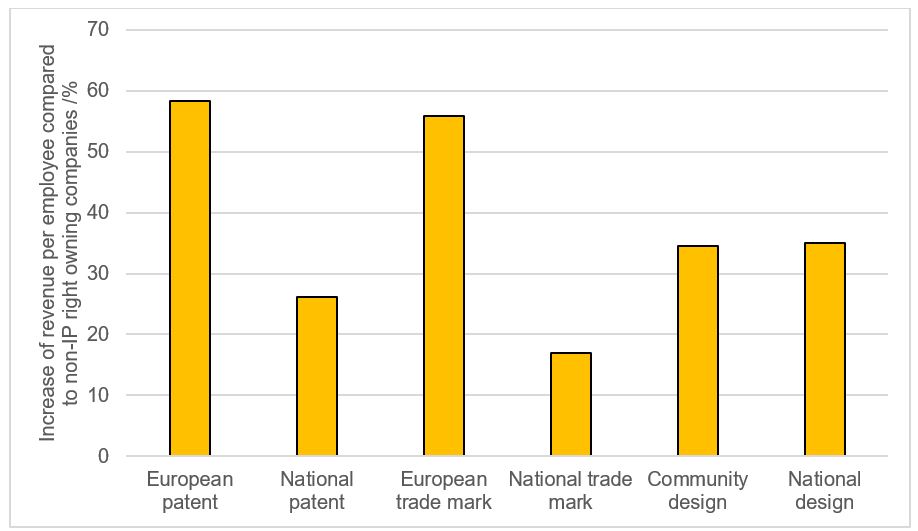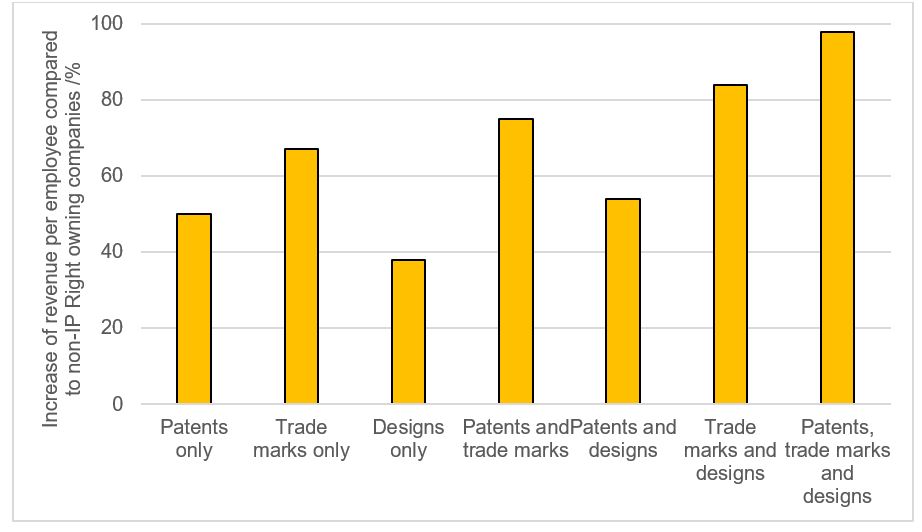10/02/2021
Last year, we reviewed a United Kingdom Intellectual Property Office (IPO) report on sectors of the economy which make the most intensive use of intellectual property (IP) rights, and how much these sectors contribute to the UK economy.
This week, the European Patent Office and the European Union Intellectual Property Office have jointly published a report on the commercial benefit of owning IP rights to European companies.*
Key findings
The report found that owning at least one IP right (i.e. at least one patent, registered trade mark, or registered design) was of significant commercial benefit to the proprietor. In particular, revenue per employee of companies owning any IP right was found to be 20.2 % higher than for companies which did not own any IP rights.
Patent owners derived the largest benefit, with a revenue per employee of €202,400, which was 36.3 % higher than for non-IP right owning companies (see Figure 1). However, both trade mark owners (20.9 %) and design owners (32.2 %) also had significantly higher revenue per employee than non-IP right owning companies.

Figure 1 – Percentage increase of revenue per employee compared to non-IP right owning companies for companies which own certain IP rights.
Regional rights may increase revenue more than national rights
Perhaps unsurprisingly, owning regional IP rights (European Patents, European Trade Marks, or Registered Community Designs, covering up to 38 countries) appeared to have a larger premium than national rights – although owning either significantly increased revenue per employee.
In particular, revenue per employee for European patent owner was 58.3 % higher compared to non-IP right owners, whereas it was still 26.1 % higher for national patent owners (see Figure 2). Similarly, European Trade Mark owners had a 55.9 % higher revenue per employee than non-IP right owners, whereas the premium for national trade mark owners was still 16.9 %.
Interestingly, the premium for national design owners of 35 % was slightly higher than that for Registered Community Design owners (34.5 %).

Figure 2 – Percentage increase of revenue per employee compared to non-IP right owning companies for companies which own certain regional and national IP rights.
SMEs benefit more than large companies
Both large companies and small and medium enterprises (SMEs) benefit from IP right ownership. Interestingly, the benefit to SMEs appeared to be significantly higher. Overall, SMEs which own IP rights had a 68 % higher revenue per employee than non-IP right owning companies, whereas large companies which own IP rights had a 18 % higher revenue per employee.
SMEs that owned more than one type of IP right benefitted the most, in particular if they owned all three types of registered IP rights (patents, trade marks, and designs) – see Figure 3.

Figure 3 – Percentage increase of revenue per employee compared to non-IP right owning companies for SMEs which own certain IP rights.
Share of patent, trade mark, and design owners
SMEs and large companies
Although SMEs’ commercial benefit from owning IP rights appeared to be larger than the benefit to large companies, they were much less likely to own any IP rights (8.7 % of all SMEs) than large companies (55.6 %).
Indeed, although significant commercial benefit can be derived by SMEs from patents and designs, only 0.4 % of SMEs had any European patents and only 0.3 % of SMEs had any Community Designs. In contrast, 13.7 % of large companies owned European patents, and 9.1 % of large companies owned Community designs.
Sectors
Unsurprisingly, the three NACE divisions (European Classification of Economic Activities) having the highest share of patent owners were scientific research (21 %), manufacture of machinery and equipment (12 %), and manufacture of motor vehicles, trailers and semi-trailer (9 %).
The three NACE divisions having the highest share of trade mark owners were manufacture of pharmaceutical products and preparations (40 %), manufacture of beverages (38 %), and scientific research and development (33 %).
The three NACE divisions with the highest share of design owners were manufacture of electrical equipment, manufacture of rubber and plastic products, and manufacture of motor vehicles, trailers and semi-trailers.
Interestingly, these numbers align well with the industries found to be the most intensive users of patents, trade marks, and registered designs in the report by the UK IPO referenced above.
Summary
This EPO/EUIPO report highlights that IP rights are of significant commercial benefit (measured in revenue per employee) to both large companies and SMEs. While owners of each of the studied IP rights were found to have significantly higher revenue per employee than non-IP right owning companies, owning a combination of patents, trade marks, and designs was linked to the largest commercial benefit. Regional rights (European patents and trade marks) were also found to result in larger premiums to owners than national rights.
Although a smaller proportion of SMEs were found to own any type of IP right compared to larger companies, the commercial benefit to SMEs of owning IP rights was found to be larger than the commercial benefit to larger companies.
At Reddie & Grose, our experts specialise in protecting the full range of IP rights, including patents, trade marks, and designs. We can advise on the best use of registered IP rights to protect your intellectual property, both nationally and internationally. If you would like to find out more about protecting your intellectual property, or how it may add value to your business, please do get in touch with us.
*The report relates to companies in all current 27 member states of the EU, and the UK, as the report relates to the period of 2007 to 2019.
This article is for general information only. Its content is not a statement of the law on any subject and does not constitute advice. Please contact Reddie & Grose LLP for advice before taking any action in reliance on it.


